Bilingual Digital Exhibit Highlights Lowcountry Latinos - College of Charleston Libraries
The oft-overlooked experiences of Lowcountry Latino communities are the subject of a new digital exhibit now freely available online.
The exhibit—formally styled Las Voces del Lowcountry—spotlights Charleston’s Latino communities and their contributions to the cultural and economic life of the region, as well as their struggles with poverty and discrimination.
“Stories are our starting point,” said Marina López, co-author of the exhibit with Kerry Taylor. “The hope is that the stories remind people that we are talking about human beings.”
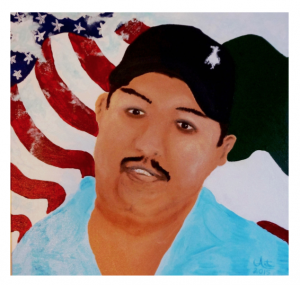
Garcia’s American Dream, painting by Art Gomez, Charleston, South Carolina, 2015.
Weaving together oral histories, photographs, art, and other primary sources, Las Voces del Lowcountry explores Latinos’ contributions to the cultural and economic life of the region, as well as their struggles with poverty and discrimination.
From harrowing travels across the U.S. border to public demonstrations against South Carolina’s S.B. 20 policy in federal court, these are the stories of Charleston’s Latino communities expressed in their own words and images.
“Stories are our starting point,” said Marina López, co-author of the exhibit with Kerry Taylor. “The hope is that they remind people that we are talking about human beings,” not disembodied facts and figures.
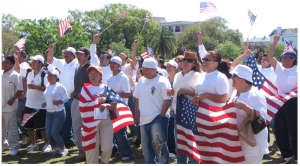
2006 Immigration Reform Rally, photograph by Marcela Rabens, Charleston, SC.
Las Voces del Lowcountry is organized thematically, documenting in turn the struggles of working class immigrants and their children, the impact of immigration policies on their lives, and the development of Latino social and political organizations.
This framework “provides an opportunity to explore their experiences with depth and nuance and to honor their struggles to make a better life for themselves and their family members,” Taylor added.
The exhibit is produced by the Lowcountry Digital History Initiative (LDHI), an award-winning digital public history project hosted by the Lowcountry Digital Library (LCDL) at the College. It marks LDHI’s first bilingual effort, reflecting the initiative’s inclusive approach to public history and its commitment to highlighting underrepresented race, class, gender, and labor histories.
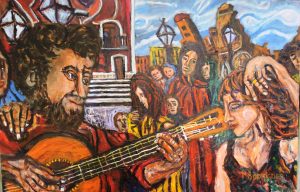
Untitled, painting by Pedro Rodriguez, Charleston, SC.
“LDHI is thrilled to work with Marina and Kerry on this exhibit not only to provide a window into Latinos’ experiences here in the tri-county area, but to also make the exhibit bilingual,” said Leah Worthington, project chief of LDHI and LCDL. “With interviewees’ stories available in Spanish and English, voices of the Lowcountry’s Latino communities will reach individuals across the region and beyond.”
Las Voces del Lowcountry is made possible through the work of graduate assistants from the College of Charleston-Citadel Graduate History M.A. Program. Empowered with curatorial and administrative experience in digital humanities, students worked to – in the words of the exhibit’s coauthors – “introduce Charleston to their newest neighbors.”
A spotlight on these “new” neighbors is long overdue. The region’s first immigrants arrived more than half a century ago, drawn to seasonal employment in the tomato sheds of Johns Island and nearby farms.
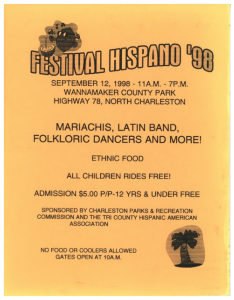
Hispanic Festival Flyer, North Charleston, September 12, 1998, courtesy of Lucy Cordero.
“Since the 1960s, thousands of natives of Mexico and Central America have worked in local agriculture,” López and Taylor write. “Over the years they were joined by smaller communities of Puerto Ricans, Argentinians, Colombians, and Brazilians,” many fleeing for their lives from political instability, government repression, or military strife.
Today, more than a quarter million Latinos call South Carolina home. The most recent U.S. Census revealed an 154% growth in the Palmetto State’s Latino population, the second highest increase in the country. Nearly 36,000 souls live in the Charleston-Berkeley-Dorchester tri-county area. These staggering figures are likely an undercount owing to fears of harassment and deportation.
And yet – in a city proud of its historical consciousness and preservation ethos – Latinos’ stories of tragedy and triumph are virtually unknown to many Charlestonians.
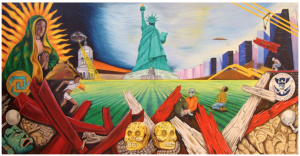
Guadalupana Torch, painting by Cornelio Campos, Durham, NC.
Las Voces del Lowcountry is a single small step in addressing this deficit in popular memory, capturing a unique moment in the development of Latino communities in Charleston and at the College. As of this year, five-plus percent of students identified as Hispanic/Latino, representing a quarter of the College’s student minority population. Earlier this month, the College welcomed to campus Lambda Theta Phi, its first Latin fraternity.
“The exhibit is a wonderful start,” said John White, Director of LDHI and Dean of Libraries at the College of Charleston. “But there is still work to be done by the region’s archives and museums to collect, preserve, and make available materials related to Latino history and culture in the region. I hope this project serves as a catalyst for more engagement with Latino communities from Charleston’s cultural heritage professionals.”
Las Voces del Lowcountry – along with nearly two dozen other digital exhibits produced by LDHI – is freely available at ldhi.library.cofc.edu. To browse 100,000-plus images in the Lowcountry Digital Library, visit lcdl.library.cofc.edu.
About the Lowcountry Digital History Initiative
The Lowcountry Digital History Initiative is a digital public history project hosted by the Lowcountry Digital Library at the College of Charleston. Funded through a pilot project grant from the Humanities Council of South Carolina and a major grant award from the Gaylord and Dorothy Donnelley Foundation, LDHI began development in 2013 and launched in 2014 as a digital consultation service, scholarly editorial resource, and online platform for partner institutions and scholars to collaborate in creating freely accessible digital public history exhibitions which focus on the Lowcountry region’s underrepresented history and culture. ldhi.library.cofc.edu
About the Lowcountry Digital Library
The Lowcountry Digital Library (LCDL) produces digital collections and projects that support research about the Lowcountry region of South Carolina and historically interconnected sites in the Atlantic World. LCDL is committed to a multifaceted approach that incorporates historical and anthropological scholarship, oral history, integrative archival practices, digital librarianship, and spatial, temporal, and environmental information. Together with its institutional partners, LCDL helps students, scholars, and a wide range of public audiences develop a better understanding of the history and culture of the South Carolina Lowcountry relative to the nation and the world. lcdl.library.cofc.edu
